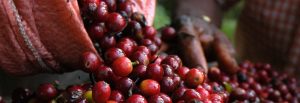From the Bean to Your Cup
Coffee grows best in remote parts of the tropics, between the Tropic of Capricorn and the Tropic of Cancer. The ideal microclimate for coffee is volcanic soil at frost-free altitudes of 4,000–6,000 feet with moderate rainfall and plenty of sunshine.
The coffee tree produces green cherries, which turn bright red as they ripen over a period of several weeks. Because the cherries don’t ripen at the same time, the best coffees are handpicked, requiring multiple trips to each tree.
Each cherry contains two pits or coffee beans, and it takes roughly 4,000 beans to yield one pound of roasted coffee – equivalent to the entire annual output from a coffee tree! If this sounds like a lot of work, you’re right. Few other agricultural crops in the world require more painstaking handwork than coffee.

Coffee is crafted like wine in many ways. Small farms with ideal microclimates and traditional, artisan growing practices produce the best tasting beans.
Coffees from growing regions have a unique flavor – Indonesians are full bodied and hold cream beautifully. A delicious Central American offers a bright and well-balanced flavor. African coffees are fruity and wine-like.
Did you know that coffee is seasonal? Winter is peak season for Indonesians, and in late spring and summer we welcome the best Central American and African coffees.
For the full 10-step process from the seed to your cup, read more from the National Coffee Association.